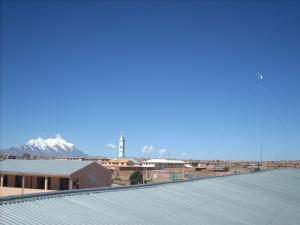 San Ignacio de Moxos connected with antennas. In San Ignacio de Moxos, an area located in the Beni region of northern Bolivia, the only internet connection available was an expensive and intermittent telephone connection. Since March 2006, thanks to the local campesino centre and wireless internet, the main institutions in the area have been interconnected, so that the inhabitants can access the internet at a quarter of the price it used to cost them, connecting them to each other, the rest of the nation and the world.
San Ignacio de Moxos connected with antennas. In San Ignacio de Moxos, an area located in the Beni region of northern Bolivia, the only internet connection available was an expensive and intermittent telephone connection. Since March 2006, thanks to the local campesino centre and wireless internet, the main institutions in the area have been interconnected, so that the inhabitants can access the internet at a quarter of the price it used to cost them, connecting them to each other, the rest of the nation and the world.
The initial assessment of the situation was not encouraging. Bolivia has one of the lowest digital connectivity rates in Latin America, ranking just above Cuba and Haiti, according to 2008 data from the America Economia portal. The connection costs made it practically impossible for the low-income population to access the internet. A broadband connection in big cities like La Paz costs 20 dollars, whereas the minimum wage in the country is less than 100 dollars a month. Well into the twenty-first century, San Ignacio de Moxos still didn’t even have broadband service.
Basic services in poor countries are usually limited to big cities, leaving a major part of the rural population without these benefits. This finding compelled CIPCA and a group of institutional stakeholders from San Ignacio de Moxos to draft a project in 2004 to improve internet connectivity in their locality.
With funding from Christian Aid, a London-based organisation fighting against poverty, the project was launched in 2006 with the installation of a satellite internet connection and a wireless network. The aim was to benefit not only the participating institutions – CIPCA, the Centre for the ethnic and Moxos people of Beni, the municipal Mayor’s office, the parish of Moxos, the health post, the education office, Radio San Ignacio, the library and music school, among others – but also to facilitate the local population’s access to internet (some 22,000 inhabitants).
“When we started installing the network, the people were amazed at our running around and our adventures up towers and over roofs. What is it? A new radio? A new channel? …In fact, it was something new: internet. After a few weeks, the people became familiar with information technologies and it was no longer just institutions using it, but also young people and children, men and women who had left “electronic anonymity” behind them and were entering the web for the first time in their lives,” Freddy Bohorquez, CIPCA representative in San Ignacio told APC.
A starting point
In March 2006, the locality already had internet. At the same time a private network for local development was set up, connecting the institutions participating in the project at a low cost for the region. Furthermore, two centres for public access to internet were installed at a quarter of the cost charged before their implementation.
Bohorquez admits that no quantitative measures to determine the impact of the project are available yet, but that the improvement in quality and speed of the institutions’ work is remarkable. The health facility uses internet to consult with other hospitals, the storing and marketing centre uses it to contact buyers and the Mayor’s office uses it to access public administration services. Furthermore, the population can now access information that was previously unavailable, not only by going to the public access centres, but also by listening to the Moxos radios that broadcast content they download from internet.
Encouraged by the initiative’s success, CIPCA submitted this project as a model to other municipalities in the country and to the national government. “Universal access and the right of access to internet services are presented as a challenge by the national government. This opens up a forum to submit the proposal for the connectivity of San Ignacio as a way of facing this challenge from the local context,” explained Bohorquez. “In a joking but challenging tone, the colleagues of CIPCA and other organisations said that if a community telecentre can operate in San Ignacio, it can operate anywhere. There is some truth to this: the difficulties are not only technical but also organisational, politically controversial and even of an “environmental” nature. “Now I can safely say that it works and that we can set ourselves the task of disseminating it everywhere,” he added.
In this respect, a project is being implemented to set up a municipal network of educational telecentres to guarantee access to internet and training in information technologies to 80 schools in the locality of Viacha in La Paz, and thus contribute to improving the quality of education and universalise basic education. The literacy rate in the region is 14.43%, and most of the population has no more than four years of schooling.
“The implementation of the San Ignacio de Moxos’ connectivity project makes us think of a new paradigm for the development of rural telecommunications, placing collective interests and local communication needs before profit-making, enabling communities to connect to the world through quality telecommunication services at a reasonable cost,” emphasises Bohorquez. A paradigm that considers users as stakeholders and makes local telecommunication service management possible. San Ignacio de Mojos is an excellent reference point.
Photo by Freddy Bohorquez